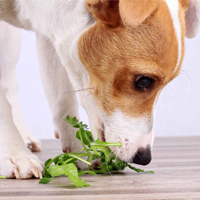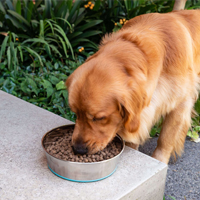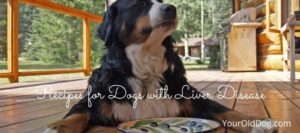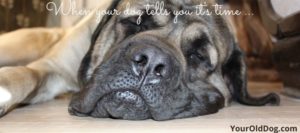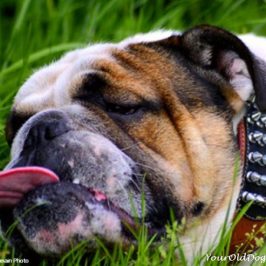
Dog Laryngeal Paralysis: Why Attaching a Leash Directly To Your Dog’s Collar Is a Bad Idea
Dog Laryngeal Paralysis
This article was generously donated by Robert Pregulman and the story is about his dog Dylan. It is with great sadness that we recently learned that Dylan crossed the rainbow bridge in October 2014.
Robert manages his own popular website called Seattle Dog spot.
In the spring of 2007, when our chocolate lab Dylan was about 6-1/2 years old, he started occasionally making a honking noise (think of what a goose honk sounds like) when he breathed heavily while playing.
We didn’t think much of it until one of the women at his daycare, Dog’s Day Out told us she noticed the noise and that it could indicate that Dylan had a breathing problem. She recommended that whenever we heard the noise we should make Dylan rest awhile and wait several minutes before playing with him again.
We did this for a couple of months, but the problem appeared to get worse, and his “honking” episodes began to occur more frequently and last longer.
We took Dylan to our vet for an examination to see if he could identify the problem, and almost immediately after we described Dylan’s symptoms, he said Dylan probably had dog laryngeal paralysis.
More Common Than You Think
Have you ever heard of it? We certainly hadn’t even though it is a somewhat common condition, especially in larger dogs.
Laryngeal paralysis (LP) occurs when the muscles on either side of the cartilage covering the opening of a dog’s trachea, or windpipe, begin to weaken.
Normally, when a dog inhales, these muscles contract and pull open the cartilage at the opening of a dog’s trachea. This allows air to flow into the trachea and travel to the dog’s lungs. The muscles relax when the dog exhales.
If a dog has LP, these muscles begin to weaken and cannot completely open the cartilage at the trachea opening when the dog inhales, so the cartilage still covering the tracheal opening gets sucked down into it. Dog laryngeal paralysis makes the dogs breathing more difficult and eventually leads to the honking sound that we heard from Dylan.
Laryngeal Paralysis in Dogs – Cause UNCLEAR
Here’s the explanation from the American College of Veterinary Surgeons on what causes dog laryngeal paralysis:
We may have been the cause of Dylan’s LP because the woman that taught his puppy training class told us to correct our dogs when we walked them by jerking their leashes (which we know now is not a good training technique). Since the leash was attached to a collar, we put a lot of pressure on his throat.
For this reason alone, you should NEVER attach a leash to a dog’s collar. Use a harness or a gentle leader. Putting pressure on a dog’s throat could lead to LP.
Dog Laryngeal Paralysis SYMPTOMS
A dog in the initial stages of LP will most likely make wheezing noises as it begins to have more difficulty breathing. It will also begin to tire more easily and may walk or play for increasingly shorter periods of time.
Because panting is a dog’s primary way of cooling itself, a dog with LP will begin to get overheated more quickly, especially in warmer weather, because it cannot breathe in enough air to cool itself.
Respiratory Distress Can Kill Your Dog
This can eventually lead to respiratory distress because, as the dog begins to overheat, it will breathe more rapidly to compensate for the reduced flow of cool air into its lungs. As the dog breathes more quickly and forcefully, the weakened muscles that pull open the cartilage at the tracheal opening are unable to keep pace with the faster breathing and the tracheal opening is blocked even more quickly.
If your dog goes into respiratory distress, do not immediately try to load it in a car and take it to the vet. Dogs in respiratory distress are overheated, and because of LP, they cannot get enough air into their lungs.
Symptoms of dog laryngeal paralysis include labored breathing, a bluish tint to the tongue or gums, and coughing.
Dogs in respiratory distress must be cooled quickly or else they can suffocate. The best thing to do is to get the dog to a shady area quickly and make it lie down. This could be difficult as your dog could begin to panic as breathing becomes harder. Be sure to remain calm so you don’t make the situation worse.
Once your dog is calm and its breathing returns to normal, call your vet to determine what he/she thinks you should do next.
You Think Your Dog Has LP – WHAT NEXT?
First, make an appointment with your vet for a general examination. Be sure to find out if your vet has had any experience with dog laryngeal paralysis. Some veterinarians have limited or no experience diagnosing dog laryngeal paralysis so they may miss it.
If your vet thinks your pet is in the initial stages of dog laryngeal paralysis and is not in any immediate danger of having an episode of respiratory distress, he/she might give you a list of things to try that will minimize the progression of the condition such as cutting back on exercising your dog in warm weather, getting a harness instead of a collar, and cooling your dog down immediately whenever it starts to wheeze.
But if your vet diagnoses your dog with a more advanced case LP, he/she should refer you to a board-certified surgeon who has extensive surgical experience with dog laryngeal paralysis.
And even if your vet diagnosed your dog with LP, the only way a board-certified surgeon can confirm the diagnosis is to examine the larynx while your dog is under sedation.
If you take your dog to a surgeon to confirm that diagnosis, he should tell you, based on the information provided by you and your vet and his examination of your dog, whether or not he thinks he should examine your dog under sedation.
Our surgeon told us that Dylan’s LP symptoms had advanced to the point that he wanted to set an appointment to sedate Dylan to confirm the diagnosis. He also noted that since sedating dogs created a lot of mental and physical stress for them, he preferred to perform the surgery to correct the dog laryngeal paralysis immediately after he confirmed the condition while Dylan was still sedated instead of scheduling another appointment for the surgery.
WHAT HAPPENS IN SURGERY?
Here’s how he said it would work. Once he sedated Dylan and confirmed he had LP, he would immediately call to let us know what he found. If he confirmed Dylan had LP that warranted surgery, he would ask us on the call to give him permission to keep Dylan sedated and perform the surgery.
Although surgeons use 3 or 4 different methods to fix LP, the most common and most effective is the Unilateral Cricoarytenoid Lateralization or “Tieback” surgery.
For a tieback, the surgeon makes an incision in the side of the dog’s neck and uses sutures to tie back the cartilage on one side of the tracheal opening far enough to allow the dog to breathe normally and prevent respiratory distress. The cartilage isn’t pulled open completely so food and fluids can’t easily enter the trachea.
The surgery lasts a couple of hours, and usually, the dog is kept overnight for observation and allowed to go home the next day.
POST-SURGICAL CARE for Dogs Diagnosed with Laryngeal Paralysis
After we agreed to the procedure, the vet told us that if he ended up doing the surgery Dylan’s recovery would be about six weeks.
Here are the post-operative orders we would have to follow:
1. For the first week, Dylan could not do any walking (except to go to the bathroom outside) because it would put pressure on both the sutures on the incision and on the cartilage and possibly pull them out. They recommended keeping him in his kennel, but instead, we created a small area in the basement for him to lie down in.
2. For the first 3 weeks, Dylan couldn’t do anything that could pull out the sutures. This included walking up stairs, getting up on furniture, or barking. Keeping him off stairs and furniture was easy. We just kept him in the basement and blocked access to the stairs and furniture.
Preventing him from barking was a little trickier since he barks A LOT whenever someone knocks at the door. We put a sign at the bottom of the stairs to our front door telling people to call us instead of knocking on our door, and that worked out fine.
3. For six weeks we couldn’t take Dylan on walks or allow him to take part in any physical activity.
4. Dylan could only eat and drink from bowls elevated enough to be almost on the same level as his mouth to prevent him from inhaling food and/or water into his lungs. In a normal dog, cartilage covers the to tracheal opening to keep food and water out of the lungs, but the tieback surgery created a permanent space in the tracheal opening where it could get through.
5. Dylan could only eat and drink in very small quantities to prevent vomiting or choking, which could cause food particles and/or stomach acid to get into his lungs.
Biggest Danger: ASPIRATION PNEUMONIA
The biggest post-operative danger was aspiration pneumonia, an inflammation of the lung caused when a dog inhales a foreign substance. Although the vast majority of dogs recover from tieback surgery with no complications, aspiration pneumonia is the most common reason for postsurgical complications and/or fatalities.
According to Vetinfo.com, the symptoms of aspiration pneumonia include coughing, rapid breathing and heart rate, a blue tint to mucous membranes, fever, nasal discharge, loss of appetite, depression, and unwillingness to exercise.
Aspiration pneumonia can be treated with antibiotics if caught soon enough, so early detection is critical. Some people take their dog’s temperature regularly after surgery to check for fever, but you should also watch for any of the other symptoms. Fortunately, Dylan didn’t develop aspiration pneumonia after his surgery.
Another potential result of the operation is that your dog could lose its bark as the surgery can damage its vocal cords. This didn’t happen to Dylan.
Your dog could also develop a seroma, which is a collection of fluid that forms around an incision. This shouldn’t be a problem, but if it gets too large, your surgeon may want to drain it. Dylan developed one about the size of a golf ball. The surgeon told us to put a warm, wet washcloth on it for about 15 minutes 2-3 times a day, and it went away on its own.
Divergent Opinions On Post Recovery Activities for DOG’s With LARYNGEAL PARALYSIS
Other than the seroma, Dylan’s recovery went smoothly, and the surgery successfully corrected his LP. When researching LP, I read that many people said that their dogs were much more active almost immediately and behaved like they were puppies again. Dylan did the same thing, and he’s still going strong even though he’s almost 10.
After your dog recovers from surgery, you must remember that your dog’s tracheal opening will always be partially open, so you must constantly guard against the danger of aspiration pneumonia.
Opinions vary regarding the best way to do this.
Some people say that they don’t allow their dog to do anything that could cause AP post-surgery, which usually means no swimming or playing in water because dogs can inhale it inadvertently into their lungs. And if the water is in a lake or the ocean, it could also have bacteria that could infect the lungs as well. Eating grass is prohibited as well because a dog could also inhale it into its lungs.
Other folks continue to feed their dogs by hand and only allow them to drink small amounts of water to reduce the possibility of AP. Additionally, they stop feeding their dog kibble or dry treats because it can inhale the dust/crumbs into its lungs.
While our vet said that everyone had to decide what they felt comfortable allowing their dog to do, the chances of getting AP from swimming or eating grass was extremely low, and that as long as we soaked kibble in water, Dylan could continue to eat it. He wasn’t concerned about dry treats either.
Raised Dog Bowls And GET RID OF COLLAR
The only things he said we should do were to put Dylan’s food and water in elevated bowls and to NEVER allow him to wear a collar, even around the house, because any pressure on his neck could rip the sutures.
We got rid of the collar and bought elevated bowls, and we decided to continue feeding him kibble mixed with canned food in warm water.
WE CAVE ON SWIMMING
We struggled with whether or not we should allow him to swim. He is a lab, so of course, his favorite activity was swimming after a tennis ball. He loves it so much he won’t even take a treat when he swims.
We decided to prohibit swimming, but that rule didn’t last long once we saw the shock and horror in his face whenever we passed water without throwing his ball. First, we threw the ball in shallow water so he didn’t have to swim, but when he realized our trick he started swimming on his own. A few days after that, he was flying off the bank or dock into the water just like always.
Did we make the correct decision? So far, yes. Dylan’s surgery was over 4 years ago, and he’s never had a case of AP. We should be able to know quickly if he ever does contract AP since 2 of its major symptoms, lethargy and not eating, would be glaringly obvious.
Seek Out Information & Decide What’s Best For Your Dog
One extremely helpful resource for me after I found out Dylan had LP was a Yahoo group for owners of dogs with LP. This group of people will happily answer any of your questions/concerns, share stories of their dogs’ surgeries, and clarify what you should expect. The group also has an extensive collection of information regarding LP that you can peruse. You must join Yahoo (it’s free) to have access to the group.
The best thing the group did for me was to provide the assurance and support that dog laryngeal paralysis is NOT a death sentence and that the vast majority of LP surgeries are successful with no complications.
You will also find people who strongly recommend against surgery or say you should never allow your dog in the water again. Their points of view are legitimate, and you just have to decide what will work best for you and your dog.
Other than the Yahoo LP group, you can get more information from the American College of Veterinary Surgeons, PetMD, the American Medical Veterinary Association, or another similar website(s).
While I hope this information is helpful regarding dog laryngeal paralysis, I prefer that your dog has a happy and healthy life with no LP.
If you have any questions, please feel free to email me at rpregulman@hotmail.com.

